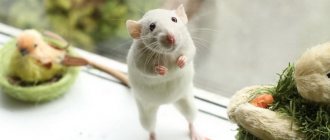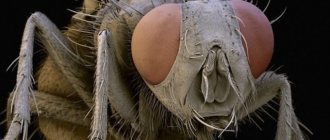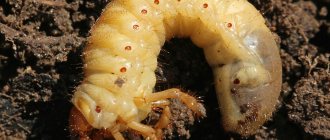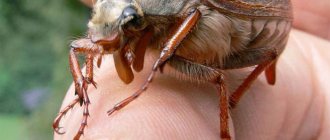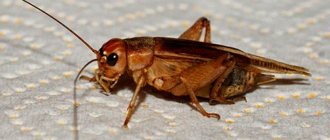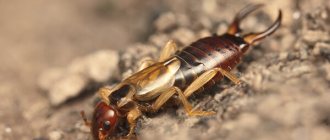- How long do fleas live?
Fleas are perhaps one of the most famous small parasitic insects. They cause the most harm and trouble to our pets:
cats and dogs, but can also be dangerous for humans, since in some cases fleas can be carriers of dangerous diseases such as pseudotuberculosis, listeriosis, tularemia. What are the habits of these little parasites, what does a flea look like, where does it live, how to fight fleas, read about all this further.
Fleas: description, structure, characteristics. What do fleas look like?
The body length of a flea is only 1-5 mm, but sometimes females of certain flea species can be much larger, up to 1 cm, especially after intensive feeding. Due to nutrition, the size of their abdomen increases, and the flea itself, as a result, increases in size. Usually the largest fleas, measuring more than 1 cm, parasitize moose and
deer.
The flea's body, consisting of the abdomen and head, is covered with a durable chitinous covering. When looking at a flea through a microscope, you can see how much the body of this insect is flattened laterally. Perhaps in some ways the flea even resembles a shrimp, only several times smaller. In fact, this shape of the flea’s body is justified by evolution itself, thanks to which the flea can easily penetrate animal fur, bird feathers, and even the folds of human clothing.
What color are fleas? The color of the flea can be reddish, yellowish, dark brown or completely black.
The flea does not have wings, and as a result cannot fly, but it jumps well. However, wings would only hinder her movement inside animal fur. The flea gets on the body of animals exclusively with the help of high and distant jumps, which are carried out due to the strong push of the second and third pairs of their legs.
The flea is also covered with numerous spines and bristles, which are scattered throughout the body, and on its head there are jagged combs - ctenidia. Thanks to this structure of the flea's body, it is very difficult to comb it out, pull it out or bite it out. It can only be destroyed by crushing it with a fingernail on a hard surface.
The flea's eyes, like those of other insects, are located on the head, and behind them there are antennae, with the help of which male fleas catch females during the mating season. These antennas are immersed in small antennal fossae.
Fleas have a piercing-sucking type of mouthparts, how does this manifest itself? The flea bites through the skin of the host (on whose body it parasitizes), widens the wound and releases saliva into it, which prevents blood clotting. Then she dives into the wound herself, trying to get to the blood vessels. By feeding on blood, fleas fill their stomach, which tends to swell greatly.
Among other things, all fleas have a special sensory organ - the pygidium, which is located in the back of their abdomen. The tactile hairs of the pygidium are capable of sensitively detecting even the slightest vibrations in the air, warning the flea of potential danger.
The female flea has reproductive organs consisting of the testicle, oviduct and spermatheca, while males have a copulatory organ - the genital claw.
Human flea - what it looks like, photo
These insects are also called bed bugs, house bugs, and basement bugs. What do bed fleas look like : they are quite large compared to other types of fleas. Adults have a body 3-4 millimeters long. With such dimensions, they jump at a distance of up to one meter. In the photographs published here you can see the parasites in detail: they have a brown body color and no wings. The shape is flattened on the sides, which allows them to move perfectly in the density of hair. Fleas are difficult to catch and squash due to their structure. They cling to the skin with their paws and can dodge human fingers. It is impossible to see an insect while jumping; its presence is revealed by movement.
How long do fleas live?
The lifespan of a flea depends on its species and habitat, and can range from several months to three years. At elevated temperatures, when the air temperature is more than 30 C, the life cycle of the blocks is reduced by 40%. And at lower temperatures, the life expectancy of a flea, on the contrary, increases as its development slows down.
How long do fleas live without an animal or, in general, without a donor? Being outside the animal's body, the flea remains without food, but since these insects are capable of not feeding for a long time, the flea easily tolerates hunger for 30-40 days. At the same time, it can live for several months, although such a starving flea reduces its activity and stops reproducing.
Dangers posed by pests
As a reward from bloodsuckers, people can get not only all sorts of local reactions on the surface of the skin, but also some dangerous diseases. They are carriers of tuberculosis, rat typhus, tularemia, listeriosis, and plague. Their consequences, if someone is unlucky enough to become infected with one of the ailments, can be very dire.
Scientists are confident that each insect is quite capable of giving people one of several hundred ailments that exist in the parasite’s body. There is no need to panic, because it is rare that a bloodsucker bite can lead to any disease. It is dangerous if bites appear on the body due to a sand flea. In this case, the risk of becoming infected increases significantly. With a strong bite, the affected area often transforms into an abscess. Bloodsuckers of this type are able to get under the skin and carry out reproduction there, as well as harmful life activities.
Video
Where do fleas live?
Strong, hardy, these insects are common everywhere, even in cold
Antarctica, where they can successfully parasitize the same penguins and seals. Most of their species live in the temperate and subtropical zones of Europe, Asia, Africa, and the Americas. Fleas are active at any time of the year. They usually live near the nests and burrows of their potential donors: warm-blooded animals.
What do fleas eat?
Fleas feed exclusively on the blood of their hosts, or donors, on whose bodies they successfully parasitize. The main victims of fleas are mammals, whose life at any time of the year is connected with the presence of a shelter. But animals that live in burrows and nests only periodically are less susceptible to flea attacks. Typically, fleas do not live on the body of their owner all the time, but jump there only to feed on their blood; having had their fill, they jump into the litter of a hole or nest.
Some fleas are associated with animals that do not have permanent housing at all; these types of fleas are stationary parasites, that is, once on the host’s body, they no longer leave it. These fleas include fleas that live on dogs and cats.
Unlike
mosquitoes, in which exclusively females are bloodsuckers, in fleas, both males and females suck blood equally. The process of saturation with blood can last from one minute to several hours. Sometimes fleas are saturated with blood in reserve, significantly inflating their abdomen.
Stationary fleas have a need for regular feeding, this is another reason why they do not leave the host’s body on their own. In between meals, they wander freely in the skin of their prey.
Interestingly, most types of fleas can parasitize different animals, for example, jump from a squirrel to a dog or cat. The only exceptions are fleas
bats that require only bats as hosts.
How fleas reproduce
Reproduction of fleas by laying larvae. On average, one sexually mature female flea lays about eight eggs at a time, and over the course of her entire life, their total number can reach five hundred. The masonry parasites are mainly located in dust, various crevices, various nests and burrows, among animal fur and in the soil.
Flea eggs hatch on average after two weeks into larvae, which are very mobile and look like worms. At first, they feed on the feces of adults and the remains of organic matter. After one to one and a half weeks, the larvae grow, after which molting begins. This happens three times over the course of a week, and then the mature individuals begin to pupate. At the end of this process, an adult insect emerges.
That is, in general, the development cycle of an ordinary flea takes about four weeks.
What do fleas eat?
It is necessary to initially note that fleas have a piercing-sucking mouthparts, that is, nature has determined that this insect should lead a parasitic lifestyle. In comparison with many other blood-sucking pests, which often require blood proteins only for females during the breeding season, for fleas these components are the main food. Both females and males are hematophagous.
After piercing the victim's skin, the flea releases special substances that simultaneously stop blood clotting and provoke its rapid flow.
Types of fleas, photos and names
Zoologists have identified up to 27 families of fleas; we will describe the most interesting of them.
human flea
It is the most common among fleas and lives everywhere. It is brown in color and 1.6-3.2 mm long. Moreover, this flea is capable of jumping to a height of up to 30 cm and half a meter in length. Unlike other fleas, it does not have thoracic or head teeth. It can parasitize various animals, including humans (hence its name). In addition to humans, it is often found in animals that have close contact with humans: primarily in cats, dogs and
horses. It is very dangerous, as it can carry the plague pathogen and cause pulicolosis - an itchy skin lesion.
Cat flea
Despite the name, this flea lives not only on cats, but also on dogs, rodents, and many other animals, sometimes even on humans. The cat flea has a short proboscis and a flat forehead, the body length is 0.75-5 mm.
Dog flea
This flea is a close relative of the cat flea, and can also live on dogs, cats and other animals, including humans. In appearance and size it is similar to a cat flea, the only difference is in life expectancy, if a cat flea lives up to 2 years, then a dog flea lives no more than 1.5 years.
Southern rat flea
This type of flea is especially dangerous because it carries plague, mouse and rat tapeworms. It lives everywhere, but to a large extent these fleas are common in areas with warm tropical climates. Females range from 1.8 to 2.7 mm in length, males are slightly smaller: 1.4 to 2 mm. They may be light or dark brown in color. Most often they parasitize rats and other rodents, living in their burrows or nearby.
Penetrating flea
She is also the sand flea or the Brazilian ground flea. Originally from Brazil and Haiti, this flea was eventually introduced to Africa, India and Pakistan, where it successfully took root. It has an oval-shaped body and a red-brown color with a white spot in the middle. The average body length of this flea species is 1 mm, and it is capable of jumping to heights of up to 30 mm. Usually lives in the grass, from where it jumps on animals, birds and humans. Penetrates under the skin of animals' feet. A person can penetrate under the nails of his toes and fingers, and lead to inflammation, tetanus, and in especially difficult cases, gangrene and amputation of limbs.
Types of fleas
Today, science knows almost two thousand different species of fleas. Of this diversity, nearly five hundred species are the indigenous inhabitants of our country. Of these, which is at least a little encouraging, only thirty species can live in residential premises.
So, if fleas appear in the house, you can be sure that they are one of the very common pests that can be found in rooms where people and pets live.
Let's look at typical representatives of these parasites by type in more detail:
domestic: houses and apartments are often inhabited by such types of fleas as human, rat, mouse, dog and cat. These pests are located directly on their host, and extremely rarely get off him, and then only for a short time. Even during reproduction, they “scatter” eggs between the fur or hair of the owner; ground or dust (basement): very small, about two millimeters, bugs, which are very difficult to see. They most often become infected in premises after visiting uninhabited houses or basements, along with dust. In the house, these parasites settle in the fabric surfaces of upholstered furniture, fleecy paths and carpets, behind baseboards. What should be said is that if you do not disinfect the infected room and how often in this case, it is unlikely that you will be able to completely get rid of these pests quickly. Only for some time, since, due to the inability to jump high, these insects constantly live on the floor and live for a long time without an animal, they themselves will begin to die, and it will be possible to clean the house;
herbal: this type of flea is not a bloodsucker. They are tiny in size and another significant difference from ordinary fleas is their dark green color. These parasites live in courtyards, from where they are carried into living quarters. They are dangerous only for indoor plants, while they are not at all harmful to humans; bed or household lice: very often confused with body lice or linen lice, but the latter are larger in size.
Flea reproduction and development
Under favorable environmental conditions, fleas reproduce all year round. At extremely low temperatures, fleas will survive without problems, but will not reproduce. Also, for successful reproduction, both partners must be well-fed; hungry fleas will not reproduce.
During sexual intercourse, the female climbs onto the male's back and pulls his genital claw into her spermatic receptacle. Interestingly, sexual intercourse in fleas can last several hours, while it takes 10-15 minutes to transfer the seed to fertilize the female.
Some time after fertilization, the female lays eggs, which pass in small portions. Typically, fleas lay 1-2 servings of 4-10 eggs per day. The process of laying eggs itself is very curious: the female forcefully pushes out the eggs, which sometimes fly considerable distances from each other. This position of the eggs makes sense, since competition between the hatched larvae subsequently decreases.
Life cycle of a flea
Fleas are insects with complete metamorphosis, and their life cycle consists of the following stages:
Flea eggs when looking at them through
microscopes are very similar to grains of rice.
Egg development lasts approximately 14 days. Then worm-like and translucent larvae emerge from them, still without legs. Wriggling, they climb into the litter of the owner's nest. Flea larvae feed on rotting organic matter, skin epithelium, or the remains of undigested blood in the excrement of their parents.
After three lines, the larva turns into a pupa. The pupal stage, depending on the type of flea, can last from several days to several months; in some species of fleas at the pupal stage, fleas overwinter, and emergence from the cocoon is timed to coincide with the onset of spring warmth.
Having emerged from the pupa, the adult flea first begins to search for its owner.
Flea bites
Flea bites cause stabbing pain when the skin is pierced and a strong desire to scratch the bitten area. A characteristic swelling usually appears at the site of the bite, somewhat similar to that from a cigarette burn. After the flea has eaten and detached itself, the edges of the wound converge, preventing bleeding, and a pinpoint hemorrhage forms at the site of the bite.
The main method of protection against little bloodsuckers is the complete destruction of fleas at home + prevention from them and other possible parasites (the same
ticks) when going outdoors.
Biological portrait
Pet owners know well what fleas are, as they often encounter this problem with their pets. If you look at the insect close up, you can see a lot of detail. Scientists, studying the flea under a microscope, noted the general similarity of all species:
- All parasites have a narrow body, laterally compressed, but smooth and covered with bristles and spines, which help them to hold well and move in fur, feathers, between the folds of linen and clothing.
- Despite the fact that there are only three pairs of legs and a complete absence of wings, the flea has good jumping ability and great speed of movement. It is almost impossible to catch it with your hands and crush it.
- The size of the flea varies from 1 to 5 mm. In some species, females can reach 10 mm in length. Behind the eyes are antennas that are used as a navigation device, determining location in space, obstacles, and picking up sounds and smells.
- Only fleas have some structural features: in the back of the abdomen there is a sensory organ that is capable of detecting the slightest vibrations in the air.
- The color of the young bloodsucker is black; brown or yellow fleas are found only in adulthood.
- The mouthparts are designed to pierce the skin and suck out blood. Unlike other blood-sucking insects, the flea's proboscis does not have a second channel for injecting an anesthetic enzyme, so bites are very painful.
Flea
The flea's wings have lost their function and turned out to be vestiges due to the insect's transition to a parasitic lifestyle. But the flea has a well-developed and strong second, and especially third, pair of legs, which helps it jump up to half a meter in height and up to one and a half meters in length, staying on the surface at any angle.
Interesting!
While jumping, the insect constantly changes direction. The jump itself gives the flea an acceleration that is 50 times greater than the acceleration of a spaceship.
The flea weighs on average 0.03 grams, reproduction occurs at a rapid pace, laying approximately 1,500 eggs during its life. The transition stage between eggs and larvae lasts about two weeks. The larvae are worm-like, move quickly, feed on decaying debris, do not like light, and try to hide in cracks, carpets and other dark places.
How to get rid of fleas in an apartment?
If you already have these parasites in your apartment, then the best remedy for fleas will be special insecticides that can destroy fleas even in the most neglected rooms. Since fleas could not even physically eat poisonous bait, means of combating them are made in the form of sprays, powders and suspensions that affect the nervous system of fleas.
When treating a room with aerosol preparations, it is necessary to temporarily evacuate all the inhabitants of the house, and then thoroughly ventilate the room and do a thorough wet cleaning.
Among the best flea medications are:
- Raptor spray with a pleasant mint scent. It is safe and effective; usually two cylinders are enough to treat a one-room apartment.
- Sinuzan is an effective and professional remedy for fleas. Its disadvantage is the unpleasant smell.
- Biorin is a professional product that destroys not only fleas, but also other insects and parasites.
After exterminating fleas, you should definitely do a general wet cleaning of the house, and generally monitor cleanliness, since unsanitary conditions and dirt are the most favorable environment for these insects.
Why are they dangerous for humans?
It is naive to believe that pests that live on animals are not dangerous to humans.
Parasites on the human body can cause:
- severe itching of the skin, scratching;
- infection with certain types of helminths;
- incidence of dangerous diseases (plague, leprosy, rat rekitsiosis, Marseilles fever);
- some types of dermatitis, entomosis;
- infectious diseases due to infection through bite wounds.
Fighting methods
Of course, insects live not only on the body of humans and animals; there are enough pests on bedding, furniture, and personal belongings, so it is necessary to carry out complete disinfection. This is done by specialized services that come to your home and process the premises.
However, you can fight parasites yourself. Here are some effective ways.
1. Specialized sprays, aerosols.
What you will need:
- anti-parasite spray;
- respirator.
What should be done:
- Pre-wet clean the apartment, shake out the carpets, wash things and bedspreads at maximum temperature.
- Move furniture away from the walls and ensure the absence of household members.
- Spray the product over the maximum area, paying special attention to upholstered furniture.
- Close the windows and doors, leave the apartment for several hours, and then ventilate thoroughly.
- Do a general cleaning of the apartment again.
2. Preparations based on permethrin.
Such preparations include specialized insect repellent shampoos for pets, as well as room treatment products.
What should be done:
- If you purchased shampoo with permethrin to treat pets, then bathe your cat or dog using anti-flea shampoo, and then dry and comb the animal.
- Treat and wash all bedding and any objects with which the pet has been in contact with this product.
- After a week, repeat the procedure.
- Insecticidal powders.
What should be done:
- Sprinkle the powder throughout the apartment: along baseboards, under beds, cabinets, wardrobes, carpets.
- You don’t have to remove the product for a while, because... The number of insects in the house depends on the time it is spent.
Folk methods of struggle
It is believed that parasites cannot tolerate the pungent odors of certain plants (wormwood, pine needles, mint, lavender), as well as tar soap.
What you will need:
- essential oil of the above herbs or dried plants;
- as an alternative: tar soap.
What should be done:
- Prepare a fairly concentrated aqueous solution of the essential oil of these herbs or brew dry herbs.
- Wash all surfaces and wash items using this solution.
- After a week, repeat the procedure.
Where to buy insect repellent
| Name of shop | Address | Drug name | How much does it cost, rub |
| Book&Shop | Moscow, st. Masterkova, 6 | Green Fort G107 Anti-Flea Biospray | 70 |
| Zooexpress | St. Petersburg, Irinovsky pr., 1 | Insect repellent shampoo "Dana" Api-San | 124 |
| Garfield | Minsk, Independence Ave., 44 | Hartz UltraGuard Plus Spray aloe spray | 29.50 bel. R |
| Rozetka | Kyiv, st. Yaroslavskaya, 57 | Insect elimination system RAPTOR | 116 UAH |
What happens during a bite
Due to its tiny size, how a flea bites makes it difficult to see both the insect itself and the site of the bite. The bite of such a pest looks like a small itchy redness with a dense area in the middle with possible microscopic hemorrhage. As a rule, a parasite bite is painful, because... the insect does not mask it and does not introduce special substances into the wound.
- The insect's mouthparts pierce the skin and draw blood from nearby capillaries. Often, the parasite can immerse the proboscis and head completely in the epithelium of the victim. During one meal, the insect usually bites 2-3 times, and can drink up to 0.5 ml of blood.
- After the bites, a characteristic path remains, which is quite itchy and may be accompanied by a burning sensation. It can be confused with bites of bed bugs or wounds from contact with plants (nettle, burdock, etc.).
- Often the bites of these insects are accompanied by extensive allergic reactions, but they can also cause the development of serious diseases, because The pathogen enters the victim's body.
Preventive actions
A well-known truth: the best control method is prevention. Preventive measures in the home, periodic treatment of pets, as well as their accessories, help prevent the presence of these parasites in the house.
So what to do:
- keep the house clean. Periodically clean carpets, wash rugs and bedspreads, and upholstery. General cleaning using special products or disinfectant aromatic compounds is especially effective;
- once every six months, especially after the summer season, hygiene procedures for animals should be carried out with special shampoos. Anti-flea collars are an excellent means of prevention. But it should be remembered that they only repel parasites, but they will not be able to rid an already infected animal of insects.
Return to description
Interesting facts about fleas
- In the 17th-18th centuries, fleas were so common among the French nobility that French aristocrats even had special items for catching fleas, so-called “flea traps,” which were small boxes like a medallion with a small hole into which fleas could accidentally fall.
- It was fleas that caused terrible epidemics of bubonic plague in the Middle Ages, which claimed many human lives. The plague fleas themselves were carried by rats and mice.
- Fleas are true jumping champions among insects; the length of a flea's jump can exceed the length of the flea itself by 100 times! Only cicadas jump further than fleas in relation to body length.
- The first serious scientific study of fleas began in the 19th century. A great contribution to their study was made by a certain Charles Rothschild, a wealthy English banker and part-time entomologist. He also collected the world's largest collection of various fleas, which is now kept in the British Museum.

